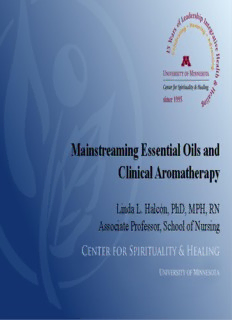
Mainstreaming Essential Oils and Clinical Aromatherapy PDF
Preview Mainstreaming Essential Oils and Clinical Aromatherapy
Mainstreaming Essential Oils and Clinical Aromatherapy Linda L. Halcón, PhD, MPH, RN Associate Professor, School of Nursing www.csh.umn.edu Objectives: Participants will: 1. Describe how essential oils are commonly used for clinical and healing purposes. 2. Review scientific principles that provide the basis for clinical aromatherapy. 3. Explore evidence for using essential oils in acute care management, disease prevention and control. 4. Describe how essential oils have been used in various patient care settings. 5. Describe how essential oils and clinical aromatherapy can be used for self-care. www.csh.umn.edu Clinical Aromatherapy: Definitions • The intentional, evidence-based use of plant essential oils for preventive or therapeutic purposes. • “Therapeutic use of essential oils from flowers, herbs, and trees for the improvement of physical, emotional and spiritual well-being.” http://www.cancer.gov/cancertopics/pdq/cam/aromath erapy/HealthProfessionals/page2 • “A therapy in which the scent of essential oils from flowers, herbs and trees is inhaled to promote health and well being.” http://www.nccam.nih.gov www.csh.umn.edu Plants and Health Care • Historically, nearly all types of healers, including physicians and nurses, used plants/herbs in their practice. • Prior to 1970, nursing and medical texts included plant based therapies. Many potent pharmaceuticals come from plants. • In many parts of the world, plant medicines continue to be relied upon in health care (self care and provider-based). www.csh.umn.edu How Medicinal Plants Have Been Used in Nursing • Herbs – Teas, syrups, extracts – Poultices – Baths, soaks • Essential oils – Massage – Inhalation www.csh.umn.edu Current Use of EO’s by Nurses • Can be part of holistic practice • Reasons used in patient care – Promoting sleep, relaxation, anxiety/ stress reduction, quality of life • Hill, Wilkinson & Simpson (2002) - Australia – 41% used EO’s on themselves – 19% used EO’s on patients – 68% had no additional training – 31% willing to refer to aromatherapist – 2nd most popular CAT for pt. use www.csh.umn.edu Aromatherapy: Clinical application in US • Essential oils are often used with other complementary/alternative or conventional treatments • Essential oils are available in the US for inhalation/topical treatments. They are not widely used by ingestion. www.csh.umn.edu Common problems that can be addressed with essential oils • Pain • Fungal infections • Depression • Bacterial infections • Insomnia • Nausea • Agitation • Burns • Quality of life • Fatigue • Tumors • Stress • Anxiety • Inflammation • Viral infections • Spiritual crisis www.csh.umn.edu What are essential oils? • Concentrated botanical substances obtained through distillation, expression, or CO2 extraction of parts of plants. – Distillation (essential oil, hydrosol or hydrolat) – Expression – citrus oils – Solvent extraction • CO2 extraction – chemistry is different www.csh.umn.edu www.csh.umn.edu
Description: